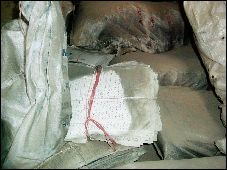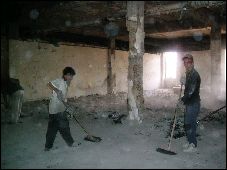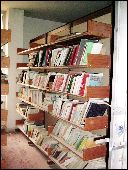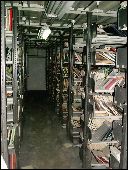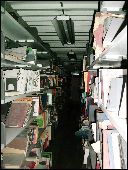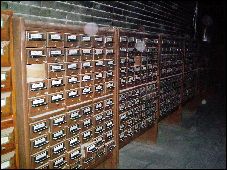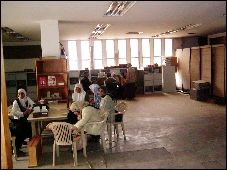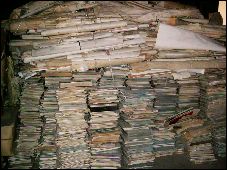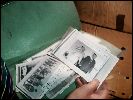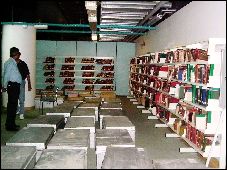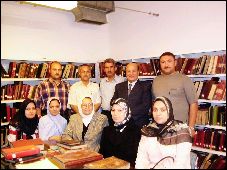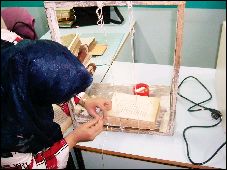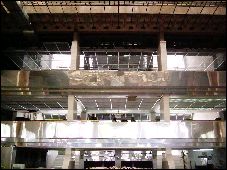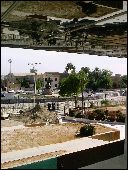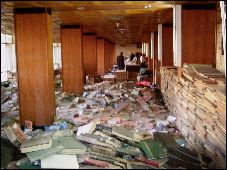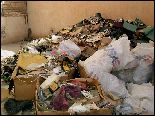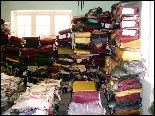The Library of Congress and the U.S. Department
of State
|
Mary-Jane Deeb, Ph.D.
Team Leader Michael Albin, Chief Alan Haley |
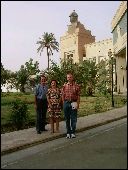 |
TABLE OF CONTENTS
Introduction
Narrative
Findings
Recommendations
Conclusion
Appendices
Library of Congress Report
Introduction
The members of the Library of Congress team who visited Baghdad in October-November 2003 to advise the Ministry of Culture on the National Library of Baghdad, wish to thank all those who made the mission possible. Their special thanks go to the Minister of Culture Mufid al-Jazaeri for his support of the mission, to Ambassador Mario Bondioli-Osio who guided and advised them and listened to their reports every day the mission was in Baghdad, to Professor John Russell who was among the very first people to visit the National library after the war, and whose opinions the members of the LC team valued highly, and to Kristen Jenkinson-McDermott without whose help and planning the team would not have been able to accomplish their work. The team is also extremely grateful to Wishyar Mohamed, the CPA advisor on libraries, who was always sharing his views with the team and enabling each party to better understand the concerns of the others. Dr. Faiza Adeed was inspiring as a woman with a vision for her country and for a great library for the future of Iraq, and we are grateful for her help and that of Acting Director General Kamil Jawad who explained to us at length the problems of his library. The LC team wishes to express its gratitude to all the staff of the National Library and to that of the House of Manuscripts as well. The team was very impressed by the dedication of the librarians and the staff members of those institutions and of the way they defended and protected their books and manuscripts, and in so doing protected the cultural heritage of Iraq. Dr. Dhamia `Abbas Samarai the director of the House of Manuscripts and her husband the former director Usama al-Naqshabandi must be praised for the important work they did there over many years. Thanks must also go to Wathiq (Tony) Hindu for his efforts at rescuing the flooded documents, and his assistance to the members of the team throughout their stay in Baghdad. The team also wishes to express their thanks to Maria Kouroupas and Bonnie Gardiner of the Cultural Property Office of the Department of State who believed in the Library of Congress' mission to assist the National Library in Baghdad, and provided the moral and financial support for the team to do so. They are also grateful to the Coalition Provisional Authority Representative Office in Washington who took care of their trip to and from Baghdad. Thanks go also to Dr. James Billington, the Librarian of Congress, Jo Ann Jenkins, the Chief of Staff, Deanna Marcum, Carolyn Brown, Nancy Davenport, Beverly Gray, Marc Roosa, Diane Van Der Reyden, who supported and encouraged the team every step of the way.
I -Narrative
A team of three specialists from the Library of Congress led by Mary-Jane Deeb, Ph.D., Arab World Area Specialist, and including Michael Albin, Chief Anglo-American Acquisitions, and Alan Haley, Senior Conservation Specialist, left for Baghdad on Saturday, October 25th . They arrived in Kuwait first, and spent the night of Sunday, October 26th at the Federal Deployment Center of the CPA located at the Hilton Resort in Mangaf.
On Monday October 27, they flew to Baghdad where they were met by Kristen Jenkinson-McDermott, Program Analyst at the Educational and Cultural Affairs Office of the US Department of State and the CPA Coordinator for the Cultural Property program in Iraq. They met with Professor John Russell, who is the CPA Senior Advisor on libraries and museums, and Ambassador Mario Bandioli-Osio who is the CPA administrator for libraries and museums.
On Tuesday, October 28, the members of the LC team were given a tour of the "Palace", met with military personnel involved with the Iraqi Ministry of Culture, and were briefed on their mission by Kristen Jenkinson-McDermott, John Russell and Ambassador Bandioli-Osio. That evening they met with Wathiq (Tony) Hindu, an Iraqi contractor for the CPA and the person who had arranged for lodging, car and security for the LC team. Each day after the team members visited sites they returned to the Palace to brief Ambassador Bandiolo-Osio and sometimes members of the military as well as to their activities that day.
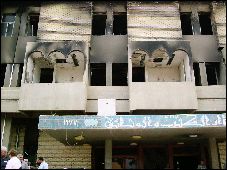 The
next morning, Wednesday, October 29, the members of the LC team
visited the site of the National Library of Iraq, the "Old
Library", as the team called it to differentiate it from the
site for the "new library" selected to replace the damaged
building. The team spent the first couple of hours visiting the
ground floor and the two floors of above the entrance the building
that had been burnt by two fires on April 10 and 14, 2003.
The
next morning, Wednesday, October 29, the members of the LC team
visited the site of the National Library of Iraq, the "Old
Library", as the team called it to differentiate it from the
site for the "new library" selected to replace the damaged
building. The team spent the first couple of hours visiting the
ground floor and the two floors of above the entrance the building
that had been burnt by two fires on April 10 and 14, 2003.
The team
also visited the stacks of the national library. The
stacks had been closed and the entrance, a large and heavy metal
door,
had been welded shut after the two fires and lootings that occurred
in April. The door was opened, on October 28, for the first
time
since the April fires, so that the LC team members could visit
and see for themselves what had happened to the collections.
The team
was thus the first non-Iraqi group to view the collection first
hand, and it was able to visit each of the five floors and see
for
itself what was in the stacks. The team also took photographs
of the collections.
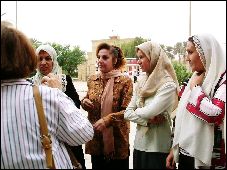 The
team members then met with the staff. Deeb and Albin sat down with
the librarians present and held discussions with them in Arabic,
identifying their names, their field of specialization and what
academic degrees they held. They also talked with the heads of departments
and found out more about what had happened to the national library,
and what the librarians thought of having a new library in the former
"Officers' Club" located a few blocks away. They met with
Acting Library Director General Kamil Jawad and Library Director
General designee Faiza Adeeb and got their views on the current
plight of the library and their aspirations for the future. Professor
Nazir Qasim joined the library discussion. He used to be director
general of the National Library in the late 1970s and early 1980s,
and taught library science to many of the current staff members
of the Library, including to the Director General designee Faiza
Adeeb. The LC team also met with Wishyar Mohamed an Iraqi expatriate
and library specialist, who is the CPA Advisor for the reconstruction
of the national library, and who, throughout the visit, coordinated
the activities of the LC team with those of the Iraqi librarians.
The
team members then met with the staff. Deeb and Albin sat down with
the librarians present and held discussions with them in Arabic,
identifying their names, their field of specialization and what
academic degrees they held. They also talked with the heads of departments
and found out more about what had happened to the national library,
and what the librarians thought of having a new library in the former
"Officers' Club" located a few blocks away. They met with
Acting Library Director General Kamil Jawad and Library Director
General designee Faiza Adeeb and got their views on the current
plight of the library and their aspirations for the future. Professor
Nazir Qasim joined the library discussion. He used to be director
general of the National Library in the late 1970s and early 1980s,
and taught library science to many of the current staff members
of the Library, including to the Director General designee Faiza
Adeeb. The LC team also met with Wishyar Mohamed an Iraqi expatriate
and library specialist, who is the CPA Advisor for the reconstruction
of the national library, and who, throughout the visit, coordinated
the activities of the LC team with those of the Iraqi librarians.
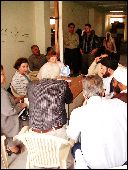
Two
religious clerics, Al-Sayyid 'Abd al-Mu'in al-Musawi and Al-Shaykh
Muhammad Jawad al-Tamimi, then joined the group. They were members
of the Hawza or Shiite clergy who had taken part of the library
and archive collection to their mosque for safekeeping after the
first fire and before the second (between April 10 and 14). The
discussion with them proceeded while their staff were bringing back
some of the books and documents that they had stored in Sadr City
in another part of Baghdad. Two architects/engineers, Mazen Hasan
Ridha, Director General of the Private Projects Directorate at the
Ministry of Housing and Construction, and his assistant Zafir 'Abd
al-Jabbar also came to the meeting and expressed the view that the
library should not be moved to the Officers' Club, and that the
damaged library was architecturally sound and could be repaired.
The following morning, Thursday October 30th , Kristen Jenkinson
and John Russell escorted the LC team to the site where the old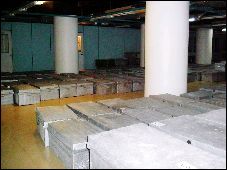 manuscripts, once housed in "Dar Saddam lil-Makhtutat",
had been hidden to protect them from looting. The primary location
was bomb shelter No. 12, in the Yarmouk district of Baghdad (although
some of the manuscript cases and the microfilms of the manuscripts
are stored elsewhere). The team met there with the head of Dar al-Makhtutat
or "House of Manuscripts" Dr. Dhamia 'Abbas Samarai, and
her retired husband and former director of that institution, Usama
al-Naqshabandi who has published several books on the Iraqi manuscript
collection. They showed the team metal cases in which 50,000 manuscripts
were stored, and the small laboratory where specialists in preservation
and conservation were working to repair damaged manuscripts. The
LC team observed what was being done, looked at and photographed
manuscripts and talked with the curators. They also met with neighbors
and others in the area who were looking after the manuscripts.
manuscripts, once housed in "Dar Saddam lil-Makhtutat",
had been hidden to protect them from looting. The primary location
was bomb shelter No. 12, in the Yarmouk district of Baghdad (although
some of the manuscript cases and the microfilms of the manuscripts
are stored elsewhere). The team met there with the head of Dar al-Makhtutat
or "House of Manuscripts" Dr. Dhamia 'Abbas Samarai, and
her retired husband and former director of that institution, Usama
al-Naqshabandi who has published several books on the Iraqi manuscript
collection. They showed the team metal cases in which 50,000 manuscripts
were stored, and the small laboratory where specialists in preservation
and conservation were working to repair damaged manuscripts. The
LC team observed what was being done, looked at and photographed
manuscripts and talked with the curators. They also met with neighbors
and others in the area who were looking after the manuscripts.
After lunch, the LC team went to visit the site where water-damaged archival documents and rare books had been stored. These materials had been found at the Board of Tourism Building where they been brought at the beginning of the war for safekeeping. Later that storage area had been flooded and Tony Hindu had been asked by the US military to get the flooded materials out of the water, which he did. Those materials were then placed in a three room apartment in an inhabited building to dry. We surveyed the apartment, photographed the rooms and some of the documents, and talked to the librarians who had been responsible for moving these documents from the library to the board of tourism.
On Friday, October 31st , the team accompanied by Kristen Jenkinson,
John Russell, Wishyar Mohamed, Faiza Adeeb and Kamal  Jawad
visited the Officers' Club, which had been selected by the CPA as
a possible site for the new national library. The team was given
a thorough tour of the premises by a military engineer, Specialist
Paul Drake, the Facility Maintenance Coordinator. Drake not only
had made a thorough inventory of all the building's infrastructural
problems, he had also prepared a report on what needed to be done,
and had developed plans to build stacks if those were to be recommended
for a new national library.
Jawad
visited the Officers' Club, which had been selected by the CPA as
a possible site for the new national library. The team was given
a thorough tour of the premises by a military engineer, Specialist
Paul Drake, the Facility Maintenance Coordinator. Drake not only
had made a thorough inventory of all the building's infrastructural
problems, he had also prepared a report on what needed to be done,
and had developed plans to build stacks if those were to be recommended
for a new national library.
The LC team also visited the North Garage of the Officers' Club that had been repaired by Iraqi engineers hired by the CPA, to assess the feasibility of using it as a temporary storage for the collections of the National Library. The team also visited the officers' library located in an adjacent building to the club to decide whether these facilities could be used for storage.
That evening the team stayed in the hotel. Ambassador
Bondioli-Osio dropped by unexpectedly to let them know about threats
of attacks on US forces the next day, and a possible strike in Baghdad.
He mentioned that some planned visits might have to be curtailed
or even canceled.
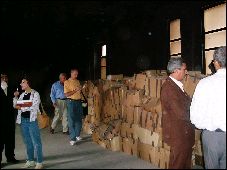 On Saturday, November 1st , the team members decided not to take
any risks, and instead of visiting the museum as had been planned
or the religious awqaf center in Sadr city, they returned to the
Old Library with John Russell who had not visited it with the team
the first time around. They were all able thus to confirm what they
had seen and what it meant and take more photographs. They also
observed the return of the materials taken by the Hawza at the time
of the April fires which were boxed in cardboard boxes and returned
for storage to the Old Library.
On Saturday, November 1st , the team members decided not to take
any risks, and instead of visiting the museum as had been planned
or the religious awqaf center in Sadr city, they returned to the
Old Library with John Russell who had not visited it with the team
the first time around. They were all able thus to confirm what they
had seen and what it meant and take more photographs. They also
observed the return of the materials taken by the Hawza at the time
of the April fires which were boxed in cardboard boxes and returned
for storage to the Old Library.
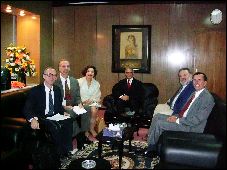
Sunday,
November 2nd , was the day when all the visits would come to fruition.
In the morning the team was invited to the "House of Fashion"
the restored building which is planned to become the new Ministry
of Culture. The members of the LC had been asked to address the
Library Board Representatives, and others including the engineers
of the Housing and Construction Board, as well as the new Minister
of Culture Mufid al Jaza'iri, and Ambassador Bondioli-Osio. Each
team member had prepared a short speech: two in Arabic and one in
English. The Ambassador spoke first, followed by the Minister, then
the LC team (Wishyar Mohamed acted as chair, moderator and translator
on the panel), and Kamil Jawad the Acting Director General of the
Library also made a statement. Ambassador Bandioli-Osio concluded
the session about the major recommendations of the panel, and then
invited the team to the office of the Minister of Culture. Deeb
then briefed the Minister on the team's findings and recommendations.
That evening Ambassador Bandioli-Osio organized a big dinner at the "Hunting Club" in honor of the Library of Congress team, at which he also invited members of CPA, the military and the Italian delegation.
II- Findings
A- National Library
1. A major section
of the front of the building of the National Library (the
Old Library) was burnt and damaged severely. Walls, ceilings,
floors, staircases, windows, doors are charred - the whole
infrastructure: including electricity, heating and air-conditioning,
plumbing and telephone is non-existent in that part of the
building. |
2. The section of the National Library that has the stacks and two large rooms that have been cleaned, is usable for temporary work. The furniture, and library equipment however, was looted. The stacks have no electricity, and therefore no heat or humidity control.
5. The other clear category of materials burnt were the microfilms. Apparently all microfilms of newspapers, and archival materials were destroyed by the same fires that destroyed the archives.
6. Private collections of
books given to the library by well known literary figures
such as 'Abd al-Rahman al-Tikriti, 'Abd al-Razzaq al-Hasani,
and Hamid al-Sharbati were dusty but unharmed. Each collection
(of an estimated 4,000 books) was organized on shelves in
separate glassed rooms on the same floor as the rooms containing
the ashes of the burnt archives and microfilms. |
7. After the two fires in April, the large metal door to the stacks was closed and sealed by the librarians to protect the collections. It was only opened when the LC team arrived. The team observed that the collection of books, newspapers (in hard copy), theses, periodicals, were unharmed. Basically, the collection had not been damaged by the fires because the stacks were in a separate location from the archives, and the stacks could be closed.
8. The stacks however, were
in a state of disarray. This seems to have been the case even
before the war, as noted in the reports of Jean-Marie Arnoult,
Edouard Metenier, Keith Watenbaugh and Hala Fattah, and demonstrates
a lack of collection maintenance by the librarians, and the
lack of funds for the upkeep of the collections. The books
in general were on shelves but some were lying on the floor
as well. Throughout, bound materials fared much better than
did the archives. The whole library seems to have suffered
from lack of funds and neglect for years before the war. |
9. On all five stack levels soot that must have come through the vents when the part of the building that housed the archives was burned, was deposited over the surfaces of the books and the shelves, and it appeared to become heavier on the upper floors where there were large chunks of cinder ash on the books.
10. Although the estimates
of the number of books and periodicals that were supposed
to be in that library vary wildly, it was clear to the team
that there could not have been on these five floors more than
1 million items (including bound periodicals and newspapers,
as well as theses). More than likely the number of titles
was lower because since the library was by law a legal deposit
for books published in Iraq, the team found several copies
of the same titles on the shelves. It is clear that (at least
in the past couple of years) instead of distributing the books
as they should have, the librarians had instead just shelved
them in the stacks. |
11. The library cards in
wooden card catalog cabinets seemed to have been scattered
about on the floor, but by and large seem to have survived
unharmed, and were placed back in the drawers by the librarians.
The team found the Iraqi librarians hard at work re-organizing
the cards. The catalogs that were completely destroyed appear
to have been those that recorded acquisitions. |
12. With respect
to personnel: the head of human resources told the LC team
that there were 160 people working at the National Library
before the war. Of these only 70 worked with books, 90 seem
to have had other roles including cleaning and guarding the
library. Of the 70 librarians only 25 had library science
degrees. Some worked as catalogers, others in acquisition,
some prepared bibliographies, some focused on microfilming
newspapers. All seemed to have worked at the library for over
20 years. |
B- House of Manuscripts
1. The department of manuscripts
was established in 1962 as part of the Iraqi National Museum
in Baghdad. It originally contained 2,526 manuscripts, but
expanded throughout the 1970s and 1980s as the government
bought manuscripts from collections around the country. In
1988, when the collection had reached 37,083 manuscripts,
the state decided to found an autonomous entity, the Saddam
House of Manuscripts. Today there are an estimated 50,000
manuscripts of which 7,000 are on loan from other institutions
or private collections and there for repair and conservation
(information gathered from talk with former director, Usama
al-Naqshabandi). |
2. The manuscripts are housed in a bomb shelter that was well maintained: it had electricity provided by a generator, which controlled the heat and humidity within the building - very important for manuscripts.
3. Most of the manuscripts have been stored in aluminum trunks
with lists of titles inside and outside the boxes, which were
closed
with locks and keys. Those trunks are strong enough to support
the weight of other heavy containers that could be placed on top
them
for storage. They also offer protection from dust, light and even
brief exposure to fire or falling debris.
4. The manuscript
center has a well trained professional staff that knows how
to preserve and conserve manuscripts. The center appeared
to be administered and run efficiently. |
5. The center seemed to have benefitted from financial, technical and professional support for several years before the war. In the past two years state support enabled it to accomplish the task of not only collecting, preserving, repairing but also of microfilming 50,000 manuscripts. However, the House of Manuscripts no longer has the money or equipment or even staff to continue doing the preservation work it needs to do.
6. The staff members did everything they could to protect those manuscripts from harm before, during and after the war. They enrolled the support of the whole neighborhood to provide security twenty-four hours a day, and were successful in preventing several attempts at looting the center.
7. The bomb shelter also had shelves with several hundred manuscripts
that were on loan and that needed preservation work.
8. Even with the war going
on outside, shelves were assembled, a reading room was installed,
and a small binding/conservation area was allocated, where
3 staff members were seen repairing paper and sewing textblocks. |
9. Some of the collection showed damage from handling and insect infestation, though no insects were in evidence as a sign of an active infestation.
C- The Senior Officers' Club
2. Accompanied by Specialist Paul Drake of the 3rd Battalion 124th Infantry Regiment 53rd Infantry Brigade of the Florida Army National Guard, the LC team visited the complex. Specialist Drake pointed out to the team the major problems with the building which he had also noted in his report including: a) "poor underground utilities resulting from inadequate design, substandard materials, corruption and neglect." b) problems with raw sewage and wastewater removal not only in the complex but in the area of the city outside the complex c) problems caused by fire and looters to the electrical system in the building, which suffered also from age and neglect - there were, however, two Rolls Royce-Dale power generation plants onsite for back up power, of which one was functional d) the heating and cooling system was not functioning, although hot water service was being restored.
3. The complex has extensive grounds on the side of the city that
can be used for building extensions to the Officers' club. At present
cars and tanks and military equipment occupy part of the grounds.
4. The complex also includes
buildings with one and two room apartments for the officers,
as well as a large officers' library. The LC team visited
the library and found hundreds of books scattered on the floors
of the library apparently by workers hired to do repairs to
the building. The space, however was adequate for storing
books. There was electricity and light, and it was above ground
so that no water seepage from underground sources could affect
the books. |
5. The team also visited the North and South Garages in the main building of the Officers' Club. The North Garage which had been suggested as a temporary storage area for the National Library's collections had several problems. There was apparent humidity on the ceilings, it was slightly below ground level meaning that rain or sewage water could seep into the garage. There was also some kind of drain throughout the garage that seemed to indicate that water had entered the garage on a regular basis before the war.
6. The team also was shown three room-size freezers off the kitchen area, which were not in working order. Drake said he had an estimate of $5,000 per freezer to get them back in working order.
D- Water Damaged Materials Stored at the Board of Tourism
1. There were 1,200 Ottoman archival documents, 4,000 rare and 'forbidden' books, 2,000 documents from the British colonial era, and about 30-40,000 documents from the "royal era" ie between 1920 and 1958 that were moved to the Board of Tourism for safekeeping, two months before the fires of April 10 and 14 which destroyed part of the national the library. The estimates were those of the librarian who was actually in charge of moving these materials.
4. A majority of the documents had been housed in multicolored boxes that had been distorted or had broken into pieces during the flooding. Dyes from the covering material of the boxes had bled onto adjacent materials. Documents, in many cases, appeared to have become separated from their folders or bindings, and bound items had lost their covers; textblocks were seen in several pieces.
5. The haste with which the rescue took place appears to have caused damage from handling to the paper. Stacking the documents in wet piles resulted in sagging edges and broken or torn items due to uneven pressure and disparate sizes supporting each other. The piles reached six to more feet in height.
6. There was insufficient air circulation to allow effective drying, and the sheer volume of wet paper prevented drying of all but the outer layers of the documents.
III- Recommendations
A- National Library
1. The present building of the National Library is unsuitable to function as a library. It has been damaged too extensively to be useful. Even if repaired the present building would be inappropriate to represent the Iraqi cultural heritage regionally and internationally. Its location is unattractive, its facilities limited, and it is rather undistinguished architecturally. Baghdad's illustrious history requires that the symbols of culture like a National Library be located in beautiful surroundings and in architecturally outstanding buildings.
2. The Senior Officers' Club that was designated as the location for a new library is perfectly suitable for a great national library. Its sensational location on the Tigris, in a historical part of the city on al-Mutannabi square, across from the oldest theater in Iraq , would highlight the importance that the new Iraqi government accords its culture and history. The Club is also architecturally one of the most modern buildings in Iraq, and it would symbolize to the world Iraq's desire to move intellectually into the 21st century. This building when renovated could become one of the most beautiful libraries in the Middle East.
3. The building of the Officers' Club, however, was not built to hold the entire collections of the National Library, nor does it have the space to accommodate the future expansion of that collection. Therefore, the Library of Congress team recommended that a new building be built in the area behind the club, for stacks for the new library. The new stacks would be a steel framed construction of four floors, and cover an area of 9,000-10,000 square meters. It would be linked by two pedestrian bridges to the main building. The out line for the construction of such a building can be found in the report of Specialist Drake, and entitled "Iraqi National Interpretive Library". It is imperative that those stacks be built. If not there can be no national library in that location.
4. It is also imperative that the Director of the Library be appointed. The Director needs to be professionally highly qualified, preferably with a doctorate in Library Science, and to have management experience, and a vision for the future of the library. The team talked with Dr. Faiza Adeeb and found her qualifications impressive and her approach to running a library efficiently most encouraging. She realizes that Iraq's premier library should be technologically advanced and that its staff should be ready to rebuild and expand its collections rapidly. She also envisions Iraq's national library as a lighthouse that will attract scholars and researchers from all over the world.
5. The team was impressed by the good work done by the librarians to protect their collections. It is important that they continue to be actively involved in the restoration of this very valuable collection which is part of Iraq's history and cultural legacy. Training for these librarians in different fields will become necessary in the future, and the Library Congress will do all it can to assist in that area.
6. The team also recommended that the archives be separated from the library. There should be three different and autonomous entities under the Ministry of Culture: a National Library, National Archives, and a House of Manuscripts. Each requires different specializations from its staff, different types of buildings and different administrations. The Library needs its own building and trained staff, and will develop links with libraries around the world as it grows and expands. The House of Manuscripts is doing very well and will need to be housed in a historical building and develop its preservation and marketing divisions to take into account the international demand for copies of microfilms of their manuscripts. The National Archives will have to be established perhaps even in the old library building. Archivists will have to be trained and the process of organizing these archival records will take many years. Librarians are not the people to do this work.
7. The building of the Officers' Club has beautiful spaces which can be used as reading rooms, conference rooms, offices, media centers, atriums, children library. However, before those spaces can be used in that way the place needs extensive work. The report of Specialist Drake surveys the building's problems including those having to do with the electrical, plumbing, heating and cooling systems, and estimates that it would cost almost $1 million to fix these problems. It would cost probably another $500,000 to wire up the building to turn it into a functioning IT library. A qualified architect/engineering firm should redesign the building. Much of the construction work can be done by Iraqi contractors.
8. Specialist Drake estimated that a new building for the stacks as described above would cost around $3 million. The team recommended therefore, that $5 million be set aside to renovate the Officers' Club and build new stacks, a process which could start immediately, and would take only six months to complete once the plans are made.
Preservation of Library Materials
1. On the main floor of the Library, in the front section near the garages, there is space that would be could be used for a new conservation facility measuring approximately 7x15meters. Plumbing is already in place in that part of the building, and the southern wall can be vented to accomodate a fume hood. Floor to ceiling windows on the front allow beautiful natural light, and can be blocked with curtains to prevent light when treating sensitive materials. There is also space for a small reformatting operation, either microfilming or digitization, or both.
2. At the same time the stacks are being built the team recommended that the staff of the library begin the process of professionally cleaning the books which were in the stacks and were covered with dust and soot. The cleaning can take place at the old library in order not to transfer soot and debris to the new facility. There is sufficient staff, and space for the staff to work with adequate light to establish a cleaning operation to prepare the books for the move to the new library.
3. The team recommended a four station operation in the front ground floor space of the old library, where the same cleaning procedures could be performed by four teams:
a) As books are brought down from the stacks, they can be left at a "landing table" where any large pieces of debris can be brushed off. At that table any physical damage the item has suffered, which would render cleaning it unwise at that time, can be documented, and the item can be separated and housed in a stable enclosure, and its cleaning can be performed later when qualified staff can respond to the task in a more cautious manner.
b) Nilfisk vacuums should be used in the second step of the operation, to clean covers and textblock edges as well as any other parts of the books that show evidence of soot deposits.
c) The staff is to be provided with large pieces of polyester screen or metal screen, in order to cover items during vacuuming if the items show weak edges that could be lost in suction.
d) Because soot has an oily quality that does not allow it to be completely or easily vacuumed, a third step in the process should consist of gently wiping with soot sponges, which do not use water; it is usually assumed that water will present a new risk: that of driving soot into the swollen paper fibers.
e) The books may then be moved to the last stage of the line operation, to be packed, either flat or with the spine down, in aluminum trunks which would be used to transfer the books to the new library site. The trunks wouldl also provide protective housing for the books as they await shelf space.
B- House of Manuscripts
1. For the reading and display of older, rare bindings, the team recommended that the reading room acquire a cradle or bolsters to support their beautiful illuminated manuscripts. Safe handling guidelines for all staff and readers should be followed to minimize wear and stress on binding structures and decorative covers. A plan to create individual enclosures for the collection, beginning with the most valuable or fragile items in the collection, should be implemented.
2. The women working to conserve the collection are to be commended for their fine efforts and developing skills. They would benefit from more specialized training, as well as the availability of archival quality conservation materials that would be more harmonious with the originals. The Preservation Directorate of the Library of Congress will offer to provide training for one or two staff members in rare book conservation. An alternative approach to providing instruction for professional skill enhancement for House of Manuscripts staff might be through a visiting Fulbright scholar or similar sponsored visit. Through communication with the Library of Congress preservation specialists, they can provide advice to the House of Manuscripts staff regarding treatments and selection of materials.
C- Water Damaged Materials
1. The over 40,000 documents damaged by water show extensive and active mold growth. Mold will definitely weaken the substrata, and in the event it continues to grow unchecked, will completely digest the surface it occupies. It is recommended that this portion of the collection be transferred as soon as possible to freezer storage wich will halt mold growth and stabilize the materials indefinitely. This in turn will allow future intervention in the form of conservation treatment, rehousing and/or reformatting. The three room-size freezers in the Officers' Club that were examined by the LC team if repaired and linked to an electric generator to ensure continuous functioning, could be used to store the damaged collection now disintegrating in the apartment building.
3. Transferring these documents will require special protective gear for all personnel involved in the operation. Packing the items will also require appropriate materials to minimize any further damage to the collection. Each item (box or volume) should be separated from adjoining materials by a sheet of freezer paper before being placed in the aluminum boxes recommended for the transfer, and the items should remain in these boxes throughout the period they are in frozen storage.
The total mass of materials is estimated to require between 1700 and 2000 cubic feet of storage, plus the space taken by the aluminum trunks themselves.
Conclusion
The enormous significance of libraries in all cultures of the world cannot be underestimated. Iraq has a long and illustrious history recorded in books in every language. School children in every corner of the world read about the ancient civilization of Mesopotamia which shaped and inspired the civilizations of the rest of mankind It is, therefore, of critical importance that this history and civilization be preserved in a library that does justice to and honors this glorious past while reflecting simultaneously Iraq's desire to move forward and become one of the great nations of the future. It is important for the Iraqi Ministry of Culture to take a bold step into the future and choose to have beautiful new National Library on the historical shores of the Tigris to inspire the youth of Iraq who will use it to create great literary and scientific works in the tradition of their forefathers.
Appendix A
Materials Required to Perform Cleaning of Books in Preparation for Move to New Facility
4 Nilfisk* vacuums
20 pcs. Wire mesh (window screen material)
4 large brushes for dirt removal
1 case Nitrile gloves, lg.; 1 case Nitrile gloves, med.
3 cases Soot sponges*
1 case rolled cotton
1 case cotton gloves, lg.
Protective outer smocks (either disposable or 2/staff member if
they are washable type)
1 case dust masks or respirator masks
UVEX protective glasses
Large polyethene bags (for damaged books)
4 rolls (5' width) of newsprint or other disposable paper
Metal Edge* or Gaylord* document boxes (quantity and size to be
determined)
1 box silicon release paper
12 large tables (cafeteria style or equivalent dimension)
Several rolls of masking tape
4 trash containers
Pencils (not pens)
Notepads
Aluminum trunks for transfer of clean books to future library site
Appendix B
Materials Needed for Transferring Water-Damaged Materials
to Freezers
Aluminum trunks (number calculated to accommodate above estimated
cubic feet of paper-based materials; any unused trunks may be reassigned
for use in transfer of National Library stack collection, described
below)
2 cases of freezer wrap or deli paper
Required for all staff handling materials with mold
2 boxes of disposable Nitrile or latex gloves, large.
Protective eye wear, one pair/staff member (UVEX Safety Glasses,
for example)
Disposable aprons
Dust masks or respirator masks
Pencils (not pens) for notations made during the packing/moving
operation
Notepaper suitable for identification of content, partial inventory
or to document condition and/or other helpful findings
| The
Library of Congress >> Especially
for Researchers >> Research
Centers April 29, 2004 |
Contact
Us: Ask a Librarian |

